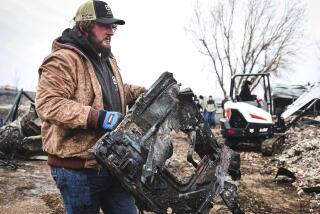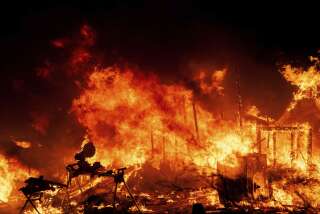Los Alamos residents evacuate as wildfire approaches
— A 50,000-acre wildfire raging through tinder-dry ponderosa forest sent up towering plumes of smoke, rained down ash and forced the mandatory evacuation Monday of Los Alamos, home to the nation’s premier nuclear weapons research lab.
The Las Conchas fire started Sunday in parched, windy conditions in the Jemez Mountains, 12 miles west of Los Alamos. By early Monday, it had destroyed 30 structures south and west of town and forced the closure of the Los Alamos National Laboratory, where scientists developed the first atomic bomb during World War II.
The blaze stirred memories of a devastating fire in May 2000 that destroyed hundreds of homes and buildings.
“The hair on the back of your neck goes up,” Los Alamos County Fire Chief Doug Tucker said of first seeing the blaze in the Santa Fe National Forest on Sunday. “I saw that plume and I thought, ‘Oh my God, here we go again.’ ”
By midafternoon Monday, the blaze had jumped a highway and burned an acre on the outskirts of the lab’s 36-square-mile complex. The charred area was used in the early 1960s for a series of underground tests with high explosives and radioactive materials. Lab officials said that offshoot of the fire was safely extinguished and no contamination had been released.
The anti-nuclear watchdog group Concerned Citizens for Nuclear Safety, however, said the fire appeared to be about 3 1/2 miles from a dumpsite where as many as 30,000 55-gallon drums of plutonium-contaminated waste were stored in tents. The group said the drums were awaiting transport to a low-level radiation dumpsite in southern New Mexico.
Lab spokesman Steve Sandoval declined to confirm whether there were any such drums on the property. But he acknowledged that low-level waste was at times put in drums and regularly taken from the lab to the Waste Isolation Pilot Project site in Carlsbad, N.M.
Sandoval said the fire was “quite a bit away” from that storage area. But he could not say what would happen if drums containing such waste were to burn.
“Unfortunately, I cannot answer that question other than to say that the material is well protected. And the lab, knowing that it works with hazardous and nuclear materials, takes great pains to make sure it is protected and locked in concrete steel vaults. And the fire poses very little threat to them.”
The fire also burned into Bandelier National Monument, site of ancient Anasazi Indian ruins.
Traffic out of Los Alamos was bumper to bumper Monday as residents fled.
“We’re just hoping for the best,” Vivian Levy said as she packed her car and her animals — again.
“Last time, I just walked out of my house and said goodbye, and that it was going to be OK,” she said. “I’m doing the same thing this time. It’s going to be OK. I’m prepared to say goodbye.”
Then she began to cry.
The evacuation was an eerie replay of the 48,000-acre Cerro Grande fire, which threatened the weapons lab after a controlled burn blew out of hand.
Sandoval, the lab spokesman, said it learned a lesson from its close call 11 years ago.
Flames from that blaze were brought under control just short of some crucial buildings. Since then, vegetation has been cleared away from lab structures to create defensible space, he said.
“We feel like we are in much better shape to deal with a wildfire than in the Cerro Grande era,” he said. “It was an eye-opener for us, to say the least.”
New Mexico has seen the driest start to the calendar year in the 117 years since record-keeping began, said Deirdre Kann, a meteorologist with the National Weather Service in Albuquerque.
Through May, Los Alamos normally receives nearly 5 inches of precipitation. But this year it has had less than an inch, Kann said.
The Las Conchas wildfire has the potential to double or triple in size, said Tucker, the fire chief, and firefighters have no idea which direction the 60-mph-plus winds will take it.
“We are preparing for the fire to go in any direction,” he said.
Special correspondent Michael Haederle in Albuquerque contributed to this report, as did the Associated Press.
More to Read
Start your day right
Sign up for Essential California for news, features and recommendations from the L.A. Times and beyond in your inbox six days a week.
You may occasionally receive promotional content from the Los Angeles Times.






